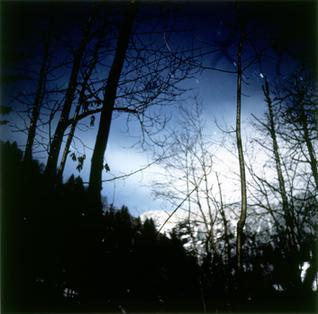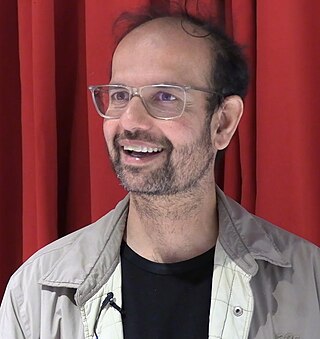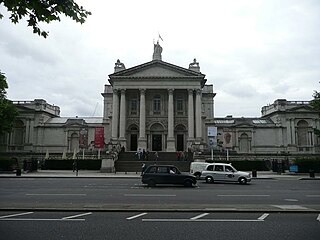External links
- Work in the Tate Gallery
- Craigie Horsfield by Museo Cantonale d’Arte Lugano
- Craigie Horsfield. The City of the People Exhibition at Fundació Antoni Tàpies
Craigie Horsfield (born 1949 in Cambridge) is an English artist. In 1996 he was nominated for the annual Turner Prize.
Horsfield described his work (photographs of the environments and people around him) as, "intimate in scale but its ambition is, uncomfortable as I find it, towards an epic dimension, to describe the history of our century, and the centuries beyond, the seething extent of the human condition." [1] He often prints the photographs many years after they were first taken, bringing into contrast memory and the present reality. [2]
His work was shown in Documenta XI, Kassel in 2002 and the Whitney Biennial in 2003.[ citation needed ]
He lives and works in London and New York. [2]

Tate is an institution that houses, in a network of four art galleries, the United Kingdom's national collection of British art, and international modern and contemporary art. It is not a government institution, but its main sponsor is the UK Department for Culture, Media and Sport.

The Turner Prize, named after the English painter J. M. W. Turner, is an annual prize presented to a British visual artist. Between 1991 and 2016, only artists under the age of 50 were eligible. The prize is awarded at Tate Britain every other year, with various venues outside of London being used in alternate years. Since its beginnings in 1984 it has become the UK's most publicised art award. The award represents all media.

Mark Wallinger is an English artist. Having previously been nominated for the Turner Prize in 1995, he won in 2007 for his installation State Britain. His work Ecce Homo (1999–2000) was the first piece to occupy the empty fourth plinth in Trafalgar Square. He represented Britain at the Venice Biennale in 2001. Labyrinth (2013), a permanent commission for Art on the Underground, was created to celebrate 150 years of the London Underground. In 2018, the permanent work Writ in Water was realized for the National Trust to celebrate where Magna Carta was signed at Runnymede.

Sir Richard Julian Long, is an English sculptor and one of the best-known British land artists.

Douglas Gordon is a Scottish artist. He won the Turner Prize in 1996, the Premio 2000 at the 47th Venice Biennale in 1997 and the Hugo Boss Prize in 1998. He lives and works in Berlin, Germany.

Gillian Wearing CBE, RA is an English conceptual artist, one of the Young British Artists, and winner of the 1997 Turner Prize. In 2007 Wearing was elected as lifetime member of the Royal Academy of Arts in London. Her statue of the suffragist Millicent Fawcett, popularly known as "Hanging out the washing", stands in London's Parliament Square.
Layla Rosalind Nashashibi is a Palestinian-English artist based in London. Nashashibi works mainly with 16 mm film but also makes paintings and prints. Her work often deals with everyday observations merged with mythological elements, considering the relationships and moments between community and extended family.

Jeremy Deller is an English conceptual, video and installation artist. Much of Deller's work is collaborative; it has a strong political aspect, in the subjects dealt with and also the devaluation of artistic ego through the involvement of other people in the creative process. He won the Turner Prize in 2004 and represented Great Britain at the Venice Biennale in 2013.
Richard Billingham is an English photographer and artist, film maker and art teacher. His work has mostly concerned his family, the place he grew up in the West Midlands, but also landscapes elsewhere.

The Stuckists Punk Victorian was the first national gallery exhibition of Stuckist art. It was held at the Walker Art Gallery and Lady Lever Art Gallery in Liverpool from 18 September 2004 to 20 February 2005 and was part of the 2004 Liverpool Biennial.

Darren James Almond is an English artist, based in London. He was nominated for the 2005 Turner Prize.

Stuckist demonstrations since 2000 have been a key part of the Stuckist art group's activities and have succeeded in giving them a high-profile both in Britain and abroad. Their primary agenda is the promotion of figurative painting and opposition to conceptual art.
Mark Titchner is an English artist, and 2006 nominee for the Turner Prize. He lives and works in London. Focusing on an exploration of words and language, in recent years much of his production has been based in the public realm both in the UK and internationally. These public works have often been created from extended group activities.

Tino Sehgal is an artist of German and Indian descent, based in Berlin, who describes his work as "constructed situations". He is also thought of as a choreographer who makes dance for the museum setting.

Sir Nicholas Serota Makes an Acquisitions Decision is one of the paintings that was made as a part of the Stuckism art movement, and is recognized as a "signature piece" for the movement. It was painted in 2000 by the Stuckism co-founder Charles Thomson, and has been exhibited in a number of shows since, as well as being featured on placards during Stuckist demonstrations against the Turner Prize.
Zarina Bhimji is a Ugandan Indian photographer, based in London. She was nominated for the Turner Prize in 2007, exhibited at Documenta 11 in 2002, and is represented in the public collections of Tate, the Museum of Contemporary Art in Chicago and Moderna Museet in Stockholm.

John Ronald Craigie Aitchison CBE RSA RA was a Scottish painter. He was best known for his many paintings of the Crucifixion, one of which hangs behind the altar in the chapter house of Liverpool Cathedral, Italian landscapes, and portraits. His simple style with bright, childlike colours defied description, and was compared to the Scottish Colourists, primitivists or naive artists, although Brian Sewell dismissed him as "a painter of too considered trifles".
Matthew Higgs is an English artist, curator, writer and publisher. His contribution to UK contemporary art has included the creation of Imprint 93, a series of artists’ editions featuring the work of artists such as Martin Creed and Jeremy Deller. During the 1990s he promoted artists outside the Young British Artists mainstream of the period.

The 2008 Turner Prize was awarded on 1 December 2008 to Mark Leckey. The £25,000 Turner Prize is awarded by the Tate to one of four nominees and is based on their work in the previous year. The other three 2008 nominees were Runa Islam, Goshka Macuga and Cathy Wilkes; for the first time since 1998, there were three female nominees. The chairman of the jury was Stephen Deuchar, director of Tate Britain. The artwork shown by the nominees at the invitational exhibition was generally unpopular with critics.
The 2007 Turner Prize for modern British art was awarded on 3 December 2007. It was the 22nd Turner Prize competition. There were four nominees for the 2007 prize and the winner was Mark Wallinger.